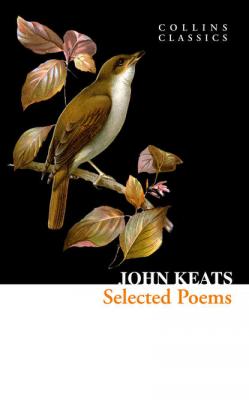ТОП просматриваемых книг сайта:
Selected Poems and Letters. John Keats
Читать онлайн.Название Selected Poems and Letters
Год выпуска 0
isbn 9780007558117
Автор произведения John Keats
Жанр Поэзия
Издательство HarperCollins
The last lines of “Ode on a Grecian Urn” are among Keats’ most famous: “‘Beauty is truth, truth beauty,’ – that is all / Ye know on earth, and all ye need to know.” It is an idea very much in keeping with Keats’ philosophy on both life and the purpose of poetry, with his sharp eye for detail and his yearning to express wonder in words. He had said as much in a November 1817 letter to his friend Benjamin Bailey, writing of “the truth of the imagination” and concluding that “whatever the imagination seizes as beauty must be truth.”
Keats’ letters are an invaluable asset in understanding the inspiration behind his writing. He took his time over his correspondence, and repeatedly ideas played with in letters appear in subsequent poems. In a letter to the poet John Hamilton Reynolds in September 1819, for example, Keats wrote of the beauty of autumn – “somehow the stubble plain looks warm” – lines which, in more polished form, found their way into “On Autumn”. In May 1818 Keats had, in another letter to Reynolds, toyed with the idea of life as a “Mansion of Many Apartments”, a notion that returned the following year in “The Fall of Hyperion: A Dream”. More than any other subject, Keats wrote about poetry itself, and though his letters, like his poems, did not achieve fame until after his death, they finally found their audience in the great poets of the twentieth century. T. S. Eliot considered them “the most notable and important ever written by any English poet”, their statements on poetry ringing true even “for greater and more mature poetry than anything Keats ever wrote”.
Love and Death
The two subjects that intrigued Keats most clashed repeatedly in the last years of his life. Towards the end of 1818, around the time he moved to Wentworth Place, Keats lost his beloved younger brother Tom to tuberculosis but also met the love of his life, Fanny Brawne. She helped him in his grief during the months in which he composed his odes, and Keats had her in mind when he wrote “Bright star, would I were as steadfast as thou”. In October 1819 he wrote to her: “I have been astonished that Men could die Martyrs for religion – I have shudder’d at it – I shudder no more – I could be martyr’d for my Religion – Love is my religion – I could die for that – I could die for you.” That same month, Fanny accepted his proposal of marriage, although her mother refused to give her consent until the failed poet had proved his financial worth.
But Keats himself had by now begun to show symptoms of tuberculosis, the disease that had killed his mother and two brothers. His condition worsened during 1820 until finally, in September, he departed for the warmer climate of Rome on doctors’ orders. Knowing that he would never return, he never wrote to Fanny again.
Following a storm-wracked voyage, Keats reached Rome in mid-November, two months after he had left London. The weather had turned wintry and he took to his bed. He wrote his last letter on 30 November, telling his friend Charles Armitage Brown: “I am leading a posthumous existence.”
Keats died in Rome on 23 February 1821. Convinced that he had left no lasting impression on the world of literature – a year earlier he had written to Fanny: “I have left nothing to make my friends proud of my memory” – he asked his doctor to arrange a plain, nameless and dateless gravestone simply saying: “Here lies One whose Name was writ in Water”. His doctor ignored this wish, and the simple tombstone that lies to this day in the Protestant Cemetery in Rome bears the following, more elaborate inscription: “This Grave / contains all that was Mortal / of a / YOUNG ENGLISH POET / Who / on his Death Bed, in the Bitterness of his Heart / at the Malicious Power of his Enemies / Desired / these Words to be / engraven on his Tomb Stone: / Here lies One / Whose Name was writ in Water.”
It was not until 1848, thirty years after their composition, that some of Keats’ own poignant thoughts on leaving the world behind were published: “When I have fears that I may cease to be / Before my pen has glean’d my teeming brain, / … And when I feel, fair creature of an hour! / That I shall never look upon thee more, / Never have relish in the faery power / Of unreflecting love! – then on the shore / Of the wide world I stand alone, and think / Till Love and Fame to nothingness do sink.”
CONTENTS
I stood tip-toe upon a little hill
Isabella; or, The Pot Of Basil. A Story from Boccaccio
O Solitude! if I must with thee dwell
On first looking into Chapman’s Homer

